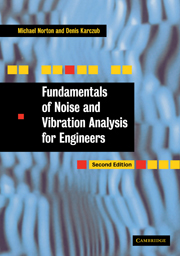Book contents
- Frontmatter
- Contents
- Preface
- Acknowledgements
- Introductory comments
- 1 Mechanical vibrations: a review of some fundamentals
- 2 Sound waves: a review of some fundamentals
- 3 Interactions between sound waves and solid structures
- 4 Noise and vibration measurement and control procedures
- 5 The analysis of noise and vibration signals
- 6 Statistical energy analysis of noise and vibration
- 7 Pipe flow noise and vibration: a case study
- 8 Noise and vibration as a diagnostic tool
- Problems
- Appendix 1 Relevant engineering noise and vibration control journals
- Appendix 2 Typical sound transmission loss values and sound absorption coefficients for some common building materials
- Appendix 3 Units and conversion factors
- Appendix 4 Physical properties of some common substances
- Answers to problems
- Index
- References
2 - Sound waves: a review of some fundamentals
Published online by Cambridge University Press: 05 June 2012
- Frontmatter
- Contents
- Preface
- Acknowledgements
- Introductory comments
- 1 Mechanical vibrations: a review of some fundamentals
- 2 Sound waves: a review of some fundamentals
- 3 Interactions between sound waves and solid structures
- 4 Noise and vibration measurement and control procedures
- 5 The analysis of noise and vibration signals
- 6 Statistical energy analysis of noise and vibration
- 7 Pipe flow noise and vibration: a case study
- 8 Noise and vibration as a diagnostic tool
- Problems
- Appendix 1 Relevant engineering noise and vibration control journals
- Appendix 2 Typical sound transmission loss values and sound absorption coefficients for some common building materials
- Appendix 3 Units and conversion factors
- Appendix 4 Physical properties of some common substances
- Answers to problems
- Index
- References
Summary
Introduction
Sound is a pressure wave that propagates through an elastic medium at some characteristic speed. It is the molecular transfer of motional energy and cannot therefore pass through a vacuum. For this wave motion to exist, the medium has to possess inertia and elasticity. Whilst vibration relates to such wave motion in structural elements, noise relates to such wave motion in fluids (gases and liquids). Two fundamental mechanisms are responsible for sound generation. They are:
the vibration of solid bodies resulting in the generation and radiation of sound energy – these sound waves are generally referred to as structure-borne sound;
flow-induced noise resulting from pressure fluctuations induced by turbulence and unsteady flows – these sound waves are generally referred to as aerodynamic sound.
With structure-borne sound, the regions of interest are generally in a fluid (usually air) at some distance from the vibrating structure. Here, the sound waves propagate through the stationary fluid (the fluid has a finite particle velocity due to the sound wave, but a zero mean velocity) from a readily identifiable source to the receiver. The region of interest does not therefore contain any sources of sound energy – i.e. the sources which generated the acoustic disturbance are external to it. A simple example is a vibrating electric motor. Classical acoustical theory (analysis of the homogeneous wave equation) can be used for the analysis of sound waves generated by these types of sources.
Information
- Type
- Chapter
- Information
- Fundamentals of Noise and Vibration Analysis for Engineers , pp. 128 - 192Publisher: Cambridge University PressPrint publication year: 2003
References
Accessibility standard: Unknown
Why this information is here
This section outlines the accessibility features of this content - including support for screen readers, full keyboard navigation and high-contrast display options. This may not be relevant for you.Accessibility Information
- 1
- Cited by
